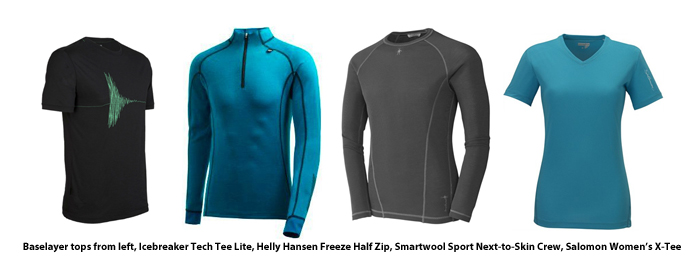Baselayers are exactly what they say – the very base of any layering system designed to keep your body temperature under control during active pursuits.
Comfort is defined as when we are neither shivering nor sweating. Discomfort is the result of accelerated heat loss – often brought about through damp clothing – so it doesn’t take much to work out that insulating layers must be kept dry at all times.

So how do you achieve the former – and never have to endure the latter?
Comfort is crucial whatever you’re doing, whether fighting off frostbite on Everest or running a marathon through the Arizona desert.
And the obvious secret to controlling your body temperature is to keep dry – protecting yourself not only from damp seeping in from the outside but – just as importantly – from building up on the inside.
Step One: Define Your Needs
Rain and perspiration are comfort’s twin enemies, and the answer is in a fool-proof layering system designed to cope with ever-changing conditions.
Defining your needs is the first step to guaranteed comfort. Keeping dry in the wet on a weekend walking trip through Wales is very different to controlling your temperature on a skiing trip in the bone-chilling cold of a Canadian winter, or trying to keep your cool on a punishing cycling climb through the French Alps.
It’s all about warmth, water-resistance…and climate control.
Baselayer T-shirts are at the very root of all layering systems, featuring different technologies aimed at a variety of sports and activities.
There are two main types of baselayer – the body-hugging compression top which protects the muscles in high energy pursuits, and a looser-fitting, less restrictive alternative.
This second option is designed to keep perspiration at bay, helping it evaporate to keep your body temperature constant at all times.
These looser-fitting T-shirts are known as wicking tees, designed to literally ‘wick’- or evaporate – sweat from your skin before it has a chance to form. Most will feature odour-control technology – often known as a moisture management system – which helps keep you fresh into the bargain.
A good example of different baselayer types comes courtesy of Icebreaker, who use pure Merino wool in a variety of weights for varying activities.
A Contradiction in Terms
Using the highest-quality wool from New Zealand Merino sheep, Icebreaker clothing is designed to keep you cool when the mercury rises, and warm when the temperatures start to plummet.
Using wool to lower your body temperature in the heat sounds like a contradiction in terms, but Icebreaker’s ground-breaking technology does exactly that.
For cold to very cold conditions, their midweight Bodyfit 260 series is ideal for all winter sports, with technical tops that ‘breathe’ brilliantly and refuse to hold sweat or odour. For the record, the longest period of time for wearing an Icebreaker non-stop in extreme conditions is 196 days!
Their Bodyfit 150 and 200 range are lighter-weight garments for less intense activities, like mountain biking and hiking, where keeping cool rather than warm is the over-riding factor.
The basic idea is to layer up, with sweat-banishing, next-to-the-skin T-shirts for warmer weather, then adding layers as and when necessary. When Icebreaker baselayers are worn together in this way, air is trapped between each individual layer, creating the impression of a single, lightweight garment and locking in the warmth.
The golden rule is never to wear cotton next to the skin if you’re going to be moving quickly. Cotton holds moisture in, leaving you feeling clammy and uncomfortable – and increasingly cold as the perspiration starts to dry on your body.
Nicki Williams writes for Gear-Zone, specialists in thermal baselayers, outdoor clothing and footwear, and camping and climbing equipment
Picture source: Gear-Zone
Baselayers For Beginners

